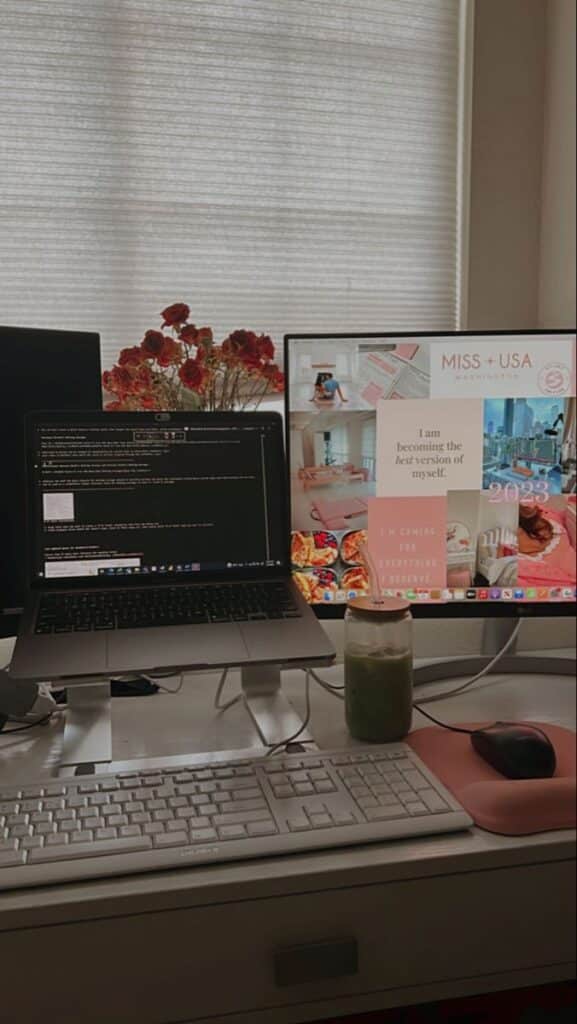Hey there, future remote work rockstar! Ever found yourself staring at your laptop in your pajamas at 3 PM, wondering if you’re doing this whole “work from home” thing right? You’re not alone. The remote work revolution has changed how we approach our careers, offering incredible flexibility but also presenting unique challenges. From battling distractions to maintaining a healthy work-life balance, mastering the art of working remotely is a journey. But don’t sweat it! We’ve got your back. This article is packed with 10 remote work tips that will transform your WFH experience from a chaotic juggle into a productive, happy, and truly fulfilling lifestyle. Get ready to supercharge your efficiency, boost your well-being, and truly own your day, no matter where your “office” happens to be.


Pros and Cons
| Pros | Cons |
|---|---|
| – Greater flexibility in daily schedule | – Potential for isolation and loneliness |
| – No commute, saving time and money | – Blurring of work-life boundaries |
| – Personalized work environment | – Increased distractions at home |
| – Enhanced autonomy and control | – Challenges with team collaboration |
| – Access to a wider range of job opportunities | – Difficulty in unplugging from work |
1. Designate a Dedicated Workspace


One of the biggest game-changers for remote work is creating a physical separation between your work life and your home life. It’s super tempting to just grab your laptop and work from the couch, bed, or kitchen table, but trust us, that quickly leads to a blurry mess where you never truly feel “off.” Imagine trying to relax in a space that constantly reminds you of deadlines and emails. Not exactly zen, right?
Your dedicated workspace doesn’t need to be a lavish home office suite (though if you have one, awesome!). It could be a specific corner of a room, a small desk in your bedroom, or even a repurposed closet. The key is that this space is only for work. When you’re there, you’re “at the office.” When you leave it, you’re “off the clock.” This mental switch is incredibly powerful for productivity and maintaining boundaries.
Think about ergonomics too. Invest in a comfortable chair that supports your back and a desk that’s at the right height. Good posture isn’t just about avoiding aches; it actually helps you focus better and feel more energized. Make sure your lighting is adequate – natural light is best, but a good desk lamp can work wonders. Personalize it with things that inspire you, but keep it clutter-free to minimize distractions. A well-organized, inspiring space can make a huge difference in your daily motivation and focus. Plus, if you’re on video calls, having a professional and tidy background is a bonus! For tips on making any small space feel bigger, check out these 7 clever hacks to make a small apartment feel bigger – applicable even for a compact home office.
2. Establish a Consistent Daily Routine

Humans thrive on routine. Even if you loved the spontaneity of waking up whenever you felt like it when you first started remote work, you probably noticed that it can quickly lead to a lack of structure, missed appointments, and a feeling of being constantly behind. A consistent routine acts as your personal anchor, providing stability and signaling to your brain when it’s time to focus and when it’s time to relax.
Start your day similarly to how you would if you were commuting. This doesn’t mean you need to get stuck in traffic, but having a morning ritual can set a positive tone. Wake up at the same time each day, get dressed (even if it’s just “work from home” casual attire), eat a proper breakfast, and perhaps do some light exercise or meditation. This ritual helps you transition from “home mode” to “work mode” mentally. Avoid rolling out of bed and straight to your laptop – that blur between personal and professional life is a fast track to burnout.
Similarly, define your working hours. If your company operates on a standard 9-to-5 schedule, try to stick to it. If you have more flexibility, choose hours that align with your peak productivity times. Block out time for focused work, meetings, and breaks. And just as important as starting your workday is ending it. Have a clear “wrap-up” routine to signal the end of your workday. This could be reviewing your to-do list for tomorrow, tidying your workspace, or simply closing your laptop and walking away. This clear demarcation is vital for your mental well-being and helps prevent work from seeping into your personal time.
3. Prioritize Breaks and Movement


Working remotely can often lead to extended periods of sitting, which is not great for your physical or mental health. When you’re in an office, you naturally get up to grab coffee, chat with colleagues, or walk to a meeting room. At home, those organic movements might disappear. That’s why consciously integrating breaks and movement into your day is one of the most crucial remote work tips.
Short, regular breaks are far more effective than trying to power through hours of work without stopping. Think of it like this: your brain needs time to reset and absorb information. A popular technique is the Pomodoro Technique, where you work for 25 minutes and then take a 5-minute break. After four cycles, you take a longer 15-30 minute break. Even if you don’t follow that strictly, aim to get up and move every hour.
What should you do during these breaks? Anything that gets you away from your screen and ideally, gets you moving. Stretch, walk around your home or garden, make a cup of tea, or do a few quick exercises. Even a few minutes of mindful breathing can re-center you. A mid-day longer break for lunch is also essential. Step away from your workspace completely. Go for a short walk outside if you can, soak up some sun, and get some fresh air. This helps prevent eye strain, reduces fatigue, and can significantly boost your focus and creativity for the rest of the day. Remember, breaks aren’t a luxury; they’re a necessity for sustained productivity and well-being.
4. Master Communication and Collaboration


In a remote setup, clear, proactive communication isn’t just good practice; it’s absolutely essential. The casual water cooler chats or quick desk-side questions vanish, so you need to be intentional about how you connect with your team. Misunderstandings can easily arise from a poorly worded email or a missed message, so mastering your communication game is a top remote work tip.
First, clarify expectations with your team and manager regarding communication channels. Which tool is for urgent matters (e.g., Slack, Teams), which is for ongoing projects (e.g., Asana, Trello), and which is for formal documentation (e.g., email)? Knowing where to communicate what helps everyone stay on the same page. Be explicit in your messages, especially in writing. Without body language or tone of voice, brevity can sometimes lead to ambiguity. Over-communicate rather than under-communicate.
Regular check-ins are also vital. Whether it’s daily stand-ups, weekly team meetings, or one-on-one sessions, make sure these are productive. Use video calls when possible – seeing faces helps build rapport and prevents feelings of isolation. Don’t be afraid to pick up the phone for a quick chat if a complex email exchange is proving inefficient. Beyond formal work discussions, make an effort to connect with colleagues on a personal level. Share a joke, ask about their weekend, or participate in virtual team-building activities. Human connection is paramount for team cohesion, and it makes the workday much more enjoyable. Think of ways to mimic those informal office interactions online.
5. Harness Effective Time Management Techniques

When your office is also your home, distractions are everywhere: the laundry pile, the tempting fridge, social media notifications, or even just the urge to take a quick nap. Without a boss looking over your shoulder, it’s easy for your focus to wander. That’s why one of the most critical remote work tips is to become a master of time management and self-discipline.
Start by creating a daily to-do list, but make it realistic. Don’t overload yourself. Prioritize tasks using methods like the Eisenhower Matrix (urgent/important) or the “Eat the Frog” technique (tackling your most difficult task first). Break down large projects into smaller, manageable steps. Seeing progress, even small wins, keeps you motivated.
Next, identify your peak productivity hours. Are you a morning person or a night owl? Schedule your most demanding tasks for when you’re most alert and focused. Use tools to help you stay on track, whether it’s a simple timer, a calendar app, or project management software. Consider “focus modes” on your phone or computer to silence notifications during deep work sessions. If you struggle with procrastination, research shows that strategies like the Pomodoro Technique (mentioned earlier) can be highly effective. For more general advice on staying focused, check out these top 6 tips on how to stay focused. Being intentional about how you spend your time will pay dividends in productivity and reduce stress.
6. Combat Isolation and Stay Connected


Working alone can be isolating, and prolonged loneliness can impact your mental health and productivity. While the convenience of remote work is fantastic, the lack of casual social interaction that comes with an office environment is a real downside for many. Actively combating this isolation is a vital remote work tip.
Beyond formal work communications, make a conscious effort to connect with your colleagues. Suggest virtual coffee breaks, team lunches, or even after-work online social gatherings. Some teams have dedicated “social” Slack channels for non-work chatter, sharing pet photos, or discussing weekend plans. These seemingly small interactions help build camaraderie and remind you that you’re part of a team, even if you’re physically apart.
But don’t stop there. Nurture your personal relationships outside of work too. Schedule regular video calls with friends and family. Join online communities or local groups related to your hobbies. If possible, work from a co-working space a few days a week, or even a coffee shop, for a change of scenery and some human presence (just be mindful of security and noise). Attend industry events, either virtually or in person, to network and feel connected to your professional field. Human connection is a fundamental need, and making time for it will significantly boost your happiness and resilience in a remote role.
7. Prioritize Self-Care and Well-being

Remote work can be intense. The lines between work and life blur, and it’s easy to fall into the trap of overworking, especially when your office is always “open.” That’s why prioritizing your mental and physical well-being is not just a good idea, it’s a non-negotiable remote work tip for long-term success and happiness.
Make sure you’re getting enough sleep. A consistent sleep schedule is crucial for cognitive function and mood. Pay attention to your diet – healthy eating fuels your brain and body, preventing energy crashes. Hydration is also key; keep a water bottle at your desk and refill it often.
Incorporate physical activity into your daily routine. This doesn’t mean you need to hit the gym for two hours every day. Even a 30-minute walk, a quick home workout, or some stretching can make a huge difference. Exercise is a fantastic stress reliever and energy booster.
Crucially, protect your mental health. Recognize the signs of burnout, such as persistent fatigue, irritability, or decreased motivation. Take mental health days when you need them. Practice mindfulness or meditation to manage stress. For some insightful ways to incorporate calm into your daily life, consider exploring these top 7 mindful living tips. Don’t hesitate to seek professional help if you’re struggling. Remember, you can’t pour from an empty cup. Taking care of yourself isn’t selfish; it’s essential for you to be effective and happy in all aspects of your life. This includes making sure you build a solid self-care routine to recharge regularly.
8. Set Clear Boundaries Between Work and Life


This is arguably one of the toughest, yet most important, remote work tips. When your home is your office, the boundaries between your professional and personal life can easily dissolve. Before you know it, you’re answering emails at midnight or thinking about work during family dinner. This blurring leads to chronic stress, burnout, and an inability to truly disconnect.
Establish clear “start” and “end” times for your workday, and stick to them. Communicate these hours to your colleagues and family. When your workday is over, physically close your laptop, put away work materials, and switch off notifications. Resist the urge to “just check one more email.” That one email often leads to twenty, and suddenly, your evening is gone.
If possible, have a separate work phone or use distinct profiles/modes on your personal devices to separate work apps from personal ones. This creates a psychological barrier. Be firm with family members or housemates about your working hours; they need to understand that even though you’re home, you’re “at work.” Similarly, be firm with yourself about not letting personal chores or errands interrupt your designated work blocks. Strong boundaries protect your time, energy, and overall sanity, allowing you to fully engage in your personal life once the workday concludes.
9. Continuously Learn and Adapt

The world of remote work is constantly evolving, with new tools, best practices, and challenges emerging all the time. To thrive, you need to be a lifelong learner and embrace adaptability. This is an often-overlooked remote work tip but incredibly powerful for sustained success.
Stay curious about new technologies and platforms that can enhance your remote workflow. Are there new project management tools your team could benefit from? Better communication apps? Explore online courses or webinars that focus on remote productivity, digital collaboration, or even specific technical skills related to your role. Many platforms offer free resources or trials.
Beyond tools, reflect on your own processes. What’s working well for you? What’s not? Are you struggling with a particular aspect of remote work, like managing distractions or feeling disconnected? Actively seek solutions. Read articles, join professional online communities, or ask colleagues for their tips. The beauty of remote work is its flexibility, but that also means you have to be proactive in shaping your own experience. Don’t be afraid to experiment with new routines or techniques until you find what truly empowers you to be your best, most productive self. This mindset of continuous improvement will keep you ahead of the curve and make your remote journey much smoother.
10. Embrace Flexibility and Enjoy the Perks

While consistency and boundaries are crucial, one of the biggest reasons people love remote work is the inherent flexibility it offers. Don’t forget to embrace and leverage this perk, within reason, as part of your overall remote work strategy. This isn’t just about discipline; it’s about enjoying the unique freedom that comes with WFH.
Does your job allow for flexible hours? Maybe you’re more productive working later in the evening and want to take a longer break during the day. Or perhaps you want to start earlier to finish sooner and enjoy an afternoon outing. Use this flexibility to your advantage to fit your work around your life, not the other way around. This could mean scheduling appointments without cutting into your workday, picking up kids from school, or even running errands when stores are less crowded.
Think about the time saved from commuting. How can you reinvest that time to improve your well-being or personal growth? Perhaps it’s an extra hour of sleep, a longer walk with your dog, or dedicating time to a hobby. The key is to be intentional about how you use this newfound freedom. This doesn’t mean sacrificing productivity or letting go of your routine, but rather optimizing your schedule to create a truly balanced and fulfilling life. Enjoy the freedom to customize your workspace, dress comfortably, and truly make your work environment your own. It’s not just about getting the job done; it’s about making remote work work for you.
Mastering remote work is truly about striking a balance. It’s about combining structure with flexibility, discipline with self-care, and effective communication with genuine connection. These 10 remote work tips aren’t just a checklist; they’re a foundation for building a productive, healthy, and happy WFH life. From setting up that dedicated workspace to remembering to step away and breathe, each tip plays a crucial role in empowering you to take control of your day.
The journey to becoming a remote work pro is ongoing, and there will always be new challenges and opportunities. But by consistently applying these strategies, you’ll not only boost your productivity but also cultivate a sense of well-being that ensures you’re thriving, not just surviving. So, go ahead, implement these tips, experiment, and find what works best for you. Your ideal remote work life isn’t just a dream; it’s within your reach. What are you waiting for? Start mastering your day, one tip at a time!






